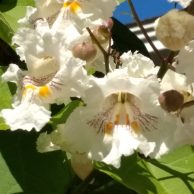 So they can support us!
So they can support us!
Last Friday Denver Botanic Gardens hosted a day-long conference on Tree Diversity. This timely subject arises because of the importance of trees to the livability of our cities and suburbs and the degree to which the effects of Climate Change have already begun to affect our urban forest. Trees help cool everything from our gardens and patios and parking lots to our cities and our planet. With stresses like sudden, dramatic temperature changes, drought, and severe windstorms, plus the devastation wrought by the Emerald Ash Borer to our millions of Ash trees, it’s time to re-evaluate the limited palette of trees we’ve been planting for many decades, and investigate new, more resilient possibilities.
Trees do a lot for us humans, so we shouldn’t forget to give them some support. When I look at the treeless ten-acre lot next to our nursery, or when I see an old photo of the CU campus with bare land around Old Main, I remember why we can’t take trees for granted in Colorado. Trees really have it hard here, but there are things we can do to help them survive and thrive.
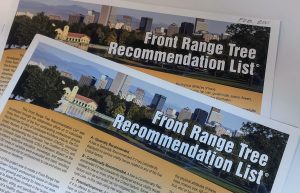 To begin, we must choose tree varieties that like Colorado conditions. The CSU website has a very valuable downloadable resource to help us, the Front Range Tree Recommendation List. 250 trees were evaluated by local experts and the trees are rated A thru D for their success. Just because you see stunning photos or have fond memories of Pin Oaks, Red Maples and Paul’s Scarlet Hawthorn doesn’t mean they will thrive in our alkaline soils, violent temperature swings and the worst fireblight in the country. For example: never plant an apple, pear or hawthorn that is not resistant to fireblight. A Radiant Crabapple is rated “A”, a Royalty Crab “D” because of fireblight. And our alkaline soils make certain nutrients, like iron, less available, resulting in weakened trees of some varieties.
To begin, we must choose tree varieties that like Colorado conditions. The CSU website has a very valuable downloadable resource to help us, the Front Range Tree Recommendation List. 250 trees were evaluated by local experts and the trees are rated A thru D for their success. Just because you see stunning photos or have fond memories of Pin Oaks, Red Maples and Paul’s Scarlet Hawthorn doesn’t mean they will thrive in our alkaline soils, violent temperature swings and the worst fireblight in the country. For example: never plant an apple, pear or hawthorn that is not resistant to fireblight. A Radiant Crabapple is rated “A”, a Royalty Crab “D” because of fireblight. And our alkaline soils make certain nutrients, like iron, less available, resulting in weakened trees of some varieties.
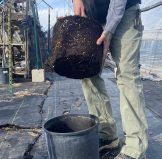 And it is important where you buy a tree. Trees are not well cared for in Big Box stores and a stressed tree is a poor investment. Some Ball-and-Burlap (B&B) trees come from Oregon or other dissimilar environments. B&B trees do better here if they are locally grown. They also do better if they are not too big. People want to start with a big tree, but the bigger the trunk diameter, the more roots are left in the ground when they are dug from the field. A tree with a 2” trunk diameter will need less water to establish and will be less stressed than a 4” diameter tree, and will start growing faster. A container-grown tree has a complete root system and will begin to grow into its new location immediately, while a field-dug B&B tree will take several years to establish a feeder-root system capable of bringing the tree enough water and nutrients. This is why we only sell container-grown stock at Harlequin’s Gardens.
And it is important where you buy a tree. Trees are not well cared for in Big Box stores and a stressed tree is a poor investment. Some Ball-and-Burlap (B&B) trees come from Oregon or other dissimilar environments. B&B trees do better here if they are locally grown. They also do better if they are not too big. People want to start with a big tree, but the bigger the trunk diameter, the more roots are left in the ground when they are dug from the field. A tree with a 2” trunk diameter will need less water to establish and will be less stressed than a 4” diameter tree, and will start growing faster. A container-grown tree has a complete root system and will begin to grow into its new location immediately, while a field-dug B&B tree will take several years to establish a feeder-root system capable of bringing the tree enough water and nutrients. This is why we only sell container-grown stock at Harlequin’s Gardens.
With our average annual rainfall between 12” and 20”, we have to water most trees, and lawn irrigation systems are not designed for trees. Most trees want deeper and less frequent waterings than bluegrass lawns. In fact, most trees would be a lot happier outside a lawn. Jack Phillips, principal of New Tree School, has said
Trees did not evolve in landscapes dominated by lawn… Progressive tree care requires a movement away from green sterility and toward a wilderness in soil.
What Jack means is that not only does grass drink a tree’s water and starve it for oxygen, but chemical lawn care also starves it for organic matter and kills off the soil life that are a tree’s allies. Trees need less water in spring when we have precipitation and twice the watering in July when it is so hot and dry. Remember: soggy soils have little space for air, and trees need oxygen to their roots as much as they need water.
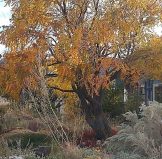 Because of our dry autumns, sunny winters, and winter warm spells it is very helpful to trees to winter-water, especially evergreen trees and trees planted in the current year. In fact, winter watering is good security against dry winters and stress, as is mulching, and both practices help keep soil biology alive. Water early on a sunny day to give time for the water to soak in before night-time freezing. Water long enough to penetrate 6-8”. No need to water if the ground is frozen. A sprinkler works better than a deep-root needle. Remember: Colorado is in a semi-arid region, we are a mile closer to the sun and we lack the winter cloud cover of the regions where many of us grew up, and where most of our trees originated.
Because of our dry autumns, sunny winters, and winter warm spells it is very helpful to trees to winter-water, especially evergreen trees and trees planted in the current year. In fact, winter watering is good security against dry winters and stress, as is mulching, and both practices help keep soil biology alive. Water early on a sunny day to give time for the water to soak in before night-time freezing. Water long enough to penetrate 6-8”. No need to water if the ground is frozen. A sprinkler works better than a deep-root needle. Remember: Colorado is in a semi-arid region, we are a mile closer to the sun and we lack the winter cloud cover of the regions where many of us grew up, and where most of our trees originated.
Our soils are not the rich glacier deposits of the Midwest. Clay is okay, but it needs more than water to grow strong trees. There are exceptions: native oaks, Russian Hawthorn, Boxelder. But unamended Colorado soils are all deficient in organic matter and nitrogen, from a tree’s point of view.
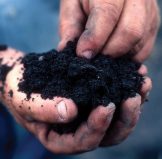 We do not believe in using chemical fertilizers which are made from natural gas, lack micronutrients and are water soluble, pushing fast growth that is soft and susceptible to fungal diseases and sucking insects. We do believe in planting a tree with 30% compost, mycorrhizae, and a little organic fertilizer. And we think periodic feeding with an organic fertilizer and minerals is good, especially if you also are giving the tree some mycorrhizae and mulching over the root zone. We favor this approach because I believe it is necessary to make up for the lack of natural pile-up of leaves and branches that feed the soil on the forest floor. Yes, there are already mycorrhizae in our poor soils, but experience shows that trees establish faster and have fewer disease problems and need less water when humans give them a good mycorrhizae supplement or compost tea. And yes, trees will grow without fertilizer, but not only will they grow faster, but trees with good nutrition will be stronger and more able to cope with Colorado’s harsh environmental conditions. The two best times to fertilize are early spring and early fall and the best time is early fall, because that is when trees are storing nutrients in their roots and stems. This is where the energy will come from if they have to make a new set of leaves after a late spring freeze or to ward off an insect or disease.
We do not believe in using chemical fertilizers which are made from natural gas, lack micronutrients and are water soluble, pushing fast growth that is soft and susceptible to fungal diseases and sucking insects. We do believe in planting a tree with 30% compost, mycorrhizae, and a little organic fertilizer. And we think periodic feeding with an organic fertilizer and minerals is good, especially if you also are giving the tree some mycorrhizae and mulching over the root zone. We favor this approach because I believe it is necessary to make up for the lack of natural pile-up of leaves and branches that feed the soil on the forest floor. Yes, there are already mycorrhizae in our poor soils, but experience shows that trees establish faster and have fewer disease problems and need less water when humans give them a good mycorrhizae supplement or compost tea. And yes, trees will grow without fertilizer, but not only will they grow faster, but trees with good nutrition will be stronger and more able to cope with Colorado’s harsh environmental conditions. The two best times to fertilize are early spring and early fall and the best time is early fall, because that is when trees are storing nutrients in their roots and stems. This is where the energy will come from if they have to make a new set of leaves after a late spring freeze or to ward off an insect or disease.
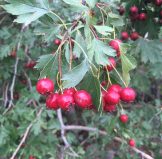 According to research done by Ralph Zentz, a Ft. Collins city forester, 70-90% of all tree problems are abiotic. That means few tree problems are caused by insects and diseases; most are caused by environmental and cultural conditions. This is good news since it means we can generally support our trees without spraying anything or having to pay to have something (especially something toxic) sprayed on our trees. So, choose a tree that likes Colorado, plant it in the sun or part shade if it prefers, water it deeply and infrequently and once a month in the winter, prune it correctly, and give it organic nutrition so that its soil allies will prosper. Then it will have the vitality to breathe carbon from the atmosphere and build a structure that stands the wind and snow, and provides shade, fruit, beauty and habitat.
According to research done by Ralph Zentz, a Ft. Collins city forester, 70-90% of all tree problems are abiotic. That means few tree problems are caused by insects and diseases; most are caused by environmental and cultural conditions. This is good news since it means we can generally support our trees without spraying anything or having to pay to have something (especially something toxic) sprayed on our trees. So, choose a tree that likes Colorado, plant it in the sun or part shade if it prefers, water it deeply and infrequently and once a month in the winter, prune it correctly, and give it organic nutrition so that its soil allies will prosper. Then it will have the vitality to breathe carbon from the atmosphere and build a structure that stands the wind and snow, and provides shade, fruit, beauty and habitat.
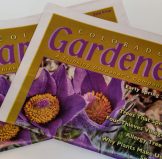 For information about Resilient Trees for Colorado, look for Mikl Brawner’s article in the upcoming Spring edition of Colorado Gardener Magazine. You can subscribe to Colorado Gardener online, or pick up a paper copy at Harlequin’s Gardens and dozens of other retail and institutional locations on the Front Range.
For information about Resilient Trees for Colorado, look for Mikl Brawner’s article in the upcoming Spring edition of Colorado Gardener Magazine. You can subscribe to Colorado Gardener online, or pick up a paper copy at Harlequin’s Gardens and dozens of other retail and institutional locations on the Front Range.
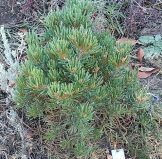
Pinus edulis Li’l Jake, Dwarf Pinon Pine
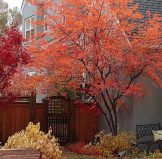
Amelanchier alnifolia, Saskatoon Serviceberry
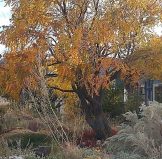
Koelreuteria paniculata, Golden Rain tree
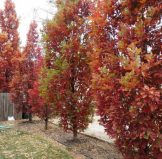
Quercus robur x Quercus alba ‘Crimschmidt’ – Crimson Spire Oaks

Pseudotsuga menziesii var. glauca – Rocky Mountain Douglas Fir
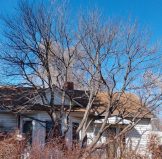
Cercis canadensis, Eastern Redbud tree
